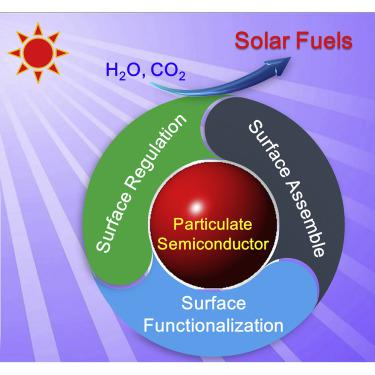Joule ( IF 38.6 ) Pub Date : 2018-08-16 , DOI: 10.1016/j.joule.2018.07.030 Shanshan Chen , Yu Qi , Can Li , Kazunari Domen , Fuxiang Zhang

|
Particulate photocatalyst-based artificial photosynthesis using water as an electron donor offers a renewable and scalable way to produce solar fuels. In constructing artificial photosynthesis systems, strategies based on modifying the semiconductor surface can remarkably influence the adsorption and activation abilities of ions/molecules, the control of the reactions involved, and the efficiencies of charge separation and catalytic conversion. In this review, three common ways of improving the photocatalytic performance of overall water splitting or CO2 reduction are summarized: (1) surface regulation by crystalline phase, crystal facet, and surface defect; (2) surface functionalization through the introduction of co-catalysts and/or a “photo-inert” metal oxide; (3) surface assembly with another semiconductor photocatalyst to form a heterostructure or an all-solid-state Z-scheme system. Challenges and future trends in the development of efficient artificial photosynthesis systems are also discussed briefly.
中文翻译:

颗粒状光催化剂向人工光合作用的表面策略
使用水作为电子给体的基于微粒光催化剂的人工光合作用提供了可再生且可扩展的生产太阳能燃料的方式。在构建人工光合作用系统中,基于修饰半导体表面的策略会显着影响离子/分子的吸附和活化能力,所涉及反应的控制以及电荷分离和催化转化的效率。在这篇综述中,三种改善整体水分解或CO 2的光催化性能的常用方法归纳总结:(1)通过晶相,晶面和表面缺陷进行表面调节;(2)通过引入助催化剂和/或“光惰性”金属氧化物进行表面官能化;(3)与另一种半导体光催化剂的表面组装,以形成异质结构或全固态Z方案系统。还简要讨论了高效人工光合作用系统开发中的挑战和未来趋势。











































 京公网安备 11010802027423号
京公网安备 11010802027423号